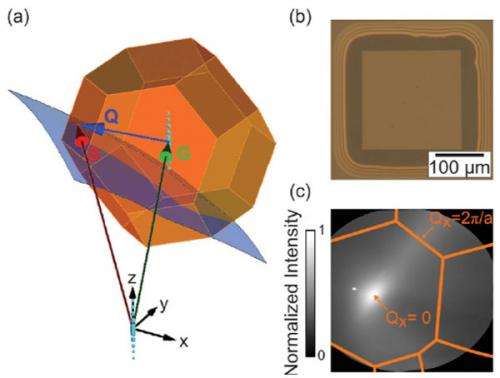Large wave-vector phonon modes in silicon nanomembranes

(Phys.org) —Modified large wave-vector phonons in semiconductor membranes via hard X-ray thermal diffuse scattering (TDS) were observed that provide new insight into the fundamental thermal and electronic properties of nanomaterials. The observation of X-ray TDS from suspended silicon membranes with thicknesses below 10 nm vastly expands the range of materials for which these vibrational modes can be studied. Understanding phonon confinement in nanostructures will enable control of thermal, optical, and electrical transport properties.
Using the high brilliance of the Advanced Photon Source at the Center for Nanoscale Materials (CNM) Hard X-Ray Nanoprobe beamline, the team quantitatively analyzed the TDS signal from zone-boundary phonons and provided insight into the lattice dynamics of nanostructures. The team included researchers from CNM's X-Ray Microscopy and Nanofabrication & Devices groups at the Argonne National Laboratory, the University of Wisconsin-Madison, and the European Synchrotron Radiation Facility.
The observation of large wave-vector phonon activity in nanoscale semiconductor membranes through synchrotron X-ray TDS demonstrates the potential for fundamentally new experimental insights into the dynamic behavior of nanoscale solids. Large wave-vector lattice vibrations have relatively smaller wavelength and thus play an increasingly key role in energy transfer and electron mobility at the nanoscale. An important feature of these modes is that they are significantly less sensitive to scattering from interfaces and defects than their small wave-vector counterparts. Study of these vibrations in nanoscale materials has been fundamentally limited both by the low wave-vector limit of optical scattering techniques and by the large sample volume requirements of X-ray and neutron inelastic scattering techniques.
Synchrotron X-ray TDS allows the simultaneous collection of vibrational information over a large range of reciprocal space that can be precisely related to the wave-vectors of phonons. The distribution of TDS intensity can be analyzed to determine the phonon dispersion—which is the relationship between the frequency and wave-vector of the vibrations. In this experiment, TDS techniques were adapted for use in nanoscale systems. The analysis of the deviations from bulk TDS intensities observed here at large wave-vectors shows that the dispersion of large-wave-vector phonons in silicon membranes with thicknesses in the tens of nanometers and smaller is strongly influenced by the development of new vibrational modes that arise because the membrane is not mechanically constrained at its surfaces. This approach will allow the experimental study and subsequent engineering of phonons in nanostructures to move beyond approximations that are valid only in the low wave-vector regime. The results contribute to an expanded toolbox for the design of novel thermal and electronic devices.
More information: G. Gopalakrishnan et al., "Thermal Diffuse Scattering as a Probe of Large-Wave-Vector Phonons in Silicon Nanostructures," Phys. Rev. Lett., 10, 205503 (2013).
Journal information: Physical Review Letters
Provided by Argonne National Laboratory


















